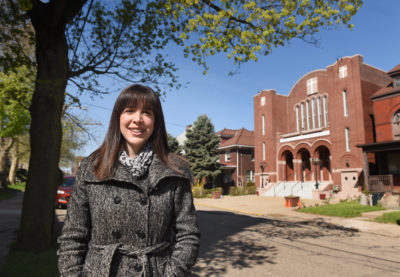Presentations
Steeltown Jews: History and Legacy at Work in Homestead, Pennsylvania
How can restoring overlooked Jewish American narratives change how we understand American history? This talk reviews the history of the Jewish community in Homestead, from the arrival of the first Jewish family in 1881 as the steel mill was built, to the closing of the synagogue in 1993 when the last members could no longer make a minyan. In parallel, the talk explores how the narratives around Homestead narrowed over time, centering on the interplay of labor and industry and ultimately erasing people and stories that don’t fit those themes. By examining the experiences of Jews in this particular milltown, we can draw out important lessons from the past and provide insights into the present-day Jewish American experience. (Presented through the Haberman Institute in 2022.)
The Destruction of the Ward, 80 Years Later
In June 1941, U.S. government announced plans to dramatically expand the Homestead’s steel mill by demolishing the diverse, working-class neighborhood called the Ward, located below the train tracks that ran through Homestead. The government and the steel mill, with the support of local politicians, community leaders, and clergy, put out propaganda that it was the patriotic duty of the 8,000 residents of the Ward to vacate their “blighted slum.” This talk explores how the destruction came to pass and why this long-ago event resonates even today. (Presented through the Battle of Homestead Foundation in June 2021.)
Homestead Hebrews: A Case Study in Digital Community Reconstitution and Analysis
Data.HomesteadHebrews.com, a database supporting multiple web-based research tools, demonstrates techniques for recreating a community and its collective history by digitizing, indexing, tagging, and analyzing a diverse set of archival records. While I developed these tools to study one particular community, the same techniques are applicable to any community with sufficient surviving records.
(Presented at the A World Beyond: Jewish Cemeteries in Turkey – Digital Humanities in Jewish Studies conference in 2021.)
The Chinese Laundrymen of Homestead and Squirrel Hill
Some of the most overlooked history that I have reconstructed, the story of the earliest Chinese immigrants to Homestead and Squirrel Hill is bleak. Everything we take for granted in the trajectory of other immigrants to these places is absent in their story. (Presented through the Squirrel Hill Historical Society in 2022.)
A Tale of Two Intertwined Communities: Squirrel Hill and Homestead
This talk explores the surprisingly symbiotic relationship between the communities of Homestead and Squirrel Hill that began in the 1890s and continues to the present day. Originally linked by long-forgotten urban infrastructure, Homestead and Squirrel Hill have since traded community and commerce for generations. Everything you think you understand about about Squirrel Hill will look quite different when contextualized within the longer history and strikingly different social fabric of its neighbor to the south. (Recorded at the Squirrel Hill Historical Society in 2020.)
Merging GIS and Genealogy to Recreate a Forgotten Community
Maps.HomesteadHebrews.com combines decades of genealogical data with GIS to rebuild a vanished street grid and recreate the forgotten Jewish community of Homestead, PA. Using Sanborn maps to create a historic address locator, plotting entries from city directories, and referencing the full range of genealogical sources, we have created an interactive tool to examine the changing settlement patterns of this community. This approach to visualizing genealogical data geospatially can aid in reconstructing the historical development of any community. (With Lauren Winkler at the North American Cartographic Society conference in 2019.)
Reconstructing Small-Town Jewish Communities in America: A Case Study
While the history of the American Jewish community is largely an urban one, most of us have at least one branch from a small town. This talk will review research approaches for studying your ancestral small town and your family’s role in it. Along the way you’ll hear lots of memorable and surprising stories of what life was like for the residents of these places. (Recorded at the International Conference on Jewish Genealogy 2015.)
In Search of a Usable Past: Reconstructing the Jewish History of Homestead, Pennsylvania
This talk examines the surviving records of Jewish Homestead to analyze the larger implications of this community’s story. Through specific research examples, Tammy will present a broader process for situating our individual family histories in the historical record in order to produce a usable past that informs our present-day conception of ourselves, our identity, and our place in the contemporary Jewish community. (Recorded at the Library of Congress in 2015.)
Press
How a woman from New Jersey found her Jewish roots in Pittsburgh
The story of a young woman from New Jersey who came to Pittsburgh to find her Jewish roots – and never left. She found those roots not in the city’s Jewish hub of Squirrel Hill, but in one of the many former steel towns that were once home to thriving Jewish communities. (Video produced by CBS Pittsburgh.)
Finding a Jewish Family’s Roots in Homestead
Tammy Hepps quit her job in New York City to research her family’s history in Homestead’s Jewish community. What did she find? (Video produced by the Pittsburgh Post-Gazette.)



